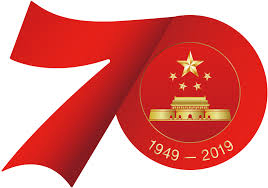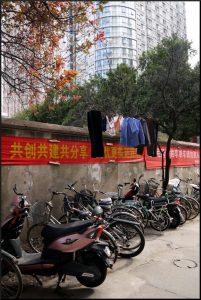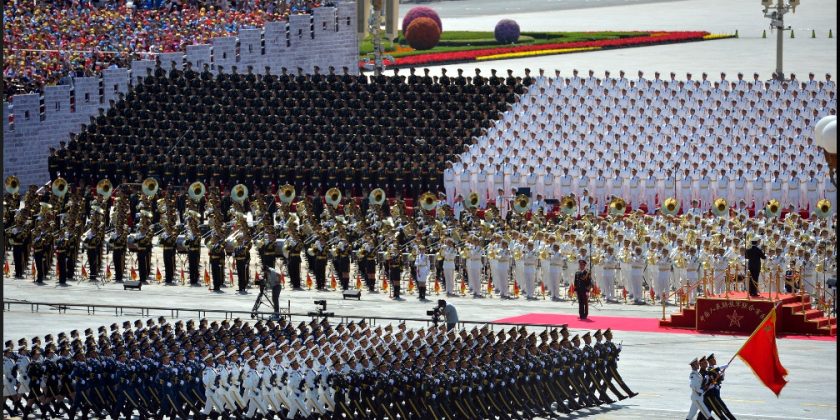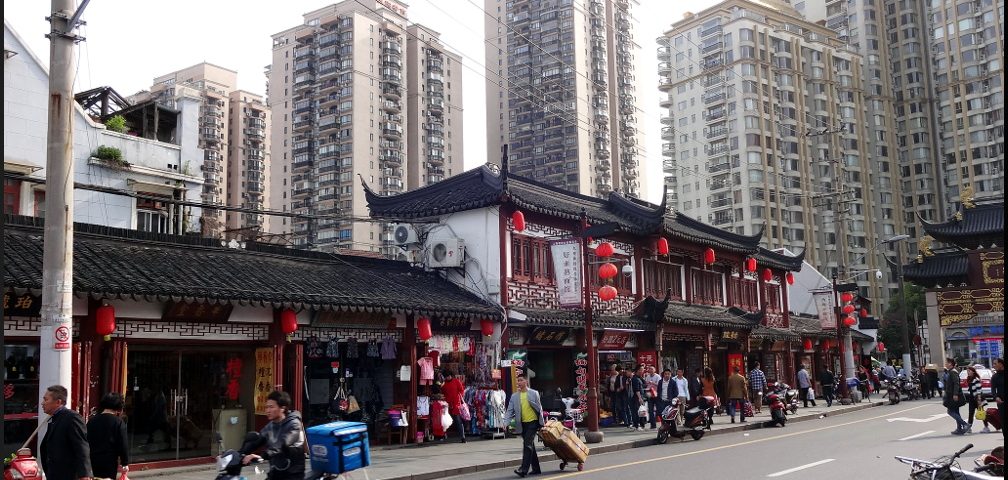by Sara Flounders and Michael Kramer, published on Workers World, October 4, 2019
The writers, who traveled in three major cities in China — Shanghai, Nanjing and Beijing — from Sept. 24 to Oct. 4 on a personal trip, sent this informal travel log to Workers World newspaper.
 October 1, 2019, was the 70th anniversary of the founding of the People’s Republic of China. We were interested in visiting China during a time when there was a huge national celebration of what we consider an unprecedented accomplishment in human history: China has met the basic material needs of its 1.4 billion population. The lives and expectations of the average person have been transformed. This revolutionary accomplishment deserves to be applauded.
October 1, 2019, was the 70th anniversary of the founding of the People’s Republic of China. We were interested in visiting China during a time when there was a huge national celebration of what we consider an unprecedented accomplishment in human history: China has met the basic material needs of its 1.4 billion population. The lives and expectations of the average person have been transformed. This revolutionary accomplishment deserves to be applauded.
The 100 prior years of colonial-style looting, unequal treaties and military occupation — a national humiliation — had reduced China to a country of staggering poverty, famines, social chaos, enforced underdevelopment and constant wars.
The first thing we took note of was that countless signs, parade themes, TV programs and most of the messaging for the anniversary reminded people that it was the firm leadership of the Chinese Communist Party that made the transformation into a united, well-organized and modern but still developing society possible. That was the core message.
Another message was of China’s 5,000-year history. For millennia it was one of the most advanced societies in culture, art and technology. This was continually raised to promote self-reliance and build modern socialism with Chinese characteristics.
We experienced two weeks of tremendous national pride. There was a great deal of discussion, everywhere that we could see, of what needed to be strengthened, what were the challenges and how to cope with still uneven development.
Siu Hin Lee, a Chinese activist who has taken several solidarity delegations to China, was tireless in personally explaining and translating so much of this experience. Lee is national coordinator of the Action LA/National Immigrant Solidarity Network and the China-US Solidarity Network.
Communicating in China
Information technology has transformed China even faster than our internet links in the West. The great majority of people seem to always have their phones in hand.
In China everyone uses the app WeChat for texting, calls, photos, videos, calling cabs, grocery shopping, metro fares and schedules, movie listings, exchanging contact information and discussion groups. Literally every social and financial transaction needs only a phone tap. Huawei centers look much like Apple centers in the U.S. Large display tables of telecommunications equipment and consumer electronics, including the newest smartphones, are surrounded by hundreds of young shoppers comparing equipment.
Since China’s hosting of the 2008 Olympic Games, street signs, subway maps and numerous restaurant menus are also in English. More than 300 million people have studied and are English-language learners. English classes are now mandatory for all Chinese K-12 students.
By comparison, there are only 200,000 K-12 students learning Mandarin in the U.S., less than 0.4 percent. Only 20 percent of U.S. students study any world language. (U.S. News & World Report, Oct. 16, 2016)
We found lots of discussion groups and genuine interest in talking with U.S. leftists, especially now as U.S. corporate and political hostility increases everyday.
It was not difficult to meet with people who have studied and traveled in the U.S. and have some grasp of its technological development, but have also seen first hand the inequality and racism.
More than 4.5 million Chinese students have studied in Western universities. Currently there are 360,000 Chinese students studying in the U.S., although China graduates more students in science, technology, engineering and math (STEM) from their own universities than the rest of the world combined. This sharp rise in educational standards and expertise in a country where the overwhelming majority of the population was formerly illiterate is another source of national pride.
We met with a group of left cyberactivists who are interested in more left-generated material from the U.S. and want to share some of their journals and views. It is not easy to figure out good translations that go both ways, but there is interest in making that happen.
A lot is going on in environmental arenas. We talked with the editor of a green living journal and with a turbine mechanic who works at a wind farm. Some of the most interesting environmental efforts are happening in newly designed second-tier cities, not only in the older megacities of Beijing and Shanghai.
We met with the Beijing City Friendship Association that has worked for decades to build friendly relations and exchanges. We had an evening discussion with a group of youth involved in the finance field, educated in the U.S. and working for big investment firms because they are expert math and software techies. But they are also socially aware.
In order to better understand China’s revolutionary history we visited the site of the 1921 founding convention of the Chinese Communist Party in Shanghai; the Yuhua Revolutionary Martyrs Cemetery and Museum at Nanjing that highlighted the thousands of youth, aged 15 to 26, who died in the liberation struggle; and the Military and Revolution Museum in Beijing. All these sites were packed with large, excited delegations of the Communist Youth League. These were not stuffy or ignored museums.
Fundamental shift in U.S./China relations
There have been countless exchanges with China for the last four decades, with U.S. corporate investors, government agencies, scientific researchers and think-tank academics. China wants to continue these exchanges. But powerful forces in the U.S., both Republicans and Democrats, are determined to exert heavy political, military and economic pressures on China to undermine state planning and state-owned industries.
However, U.S. hostility appears to most sharply undercut Chinese capitalists, who have benefited disproportionately from the past four decades of opening to Western investment. This is the one grouping who, in their own self-interest, might have been most willing to concede to U.S. trade demands.
Many people we met in China raised the significance of meeting us now. The new U.S. sanctions on the state-owned Chinese freight fleet Cosco — the largest in the world with more than 1,000 cargo ships and 100 super tankers — hit just after we arrived.
These far-reaching sanctions, along with the escalating military threats going back to Obama’s military Asia Pivot, and now Trump’s trade war, confirm that U.S.-China relations are fundamentally shifting. The increasingly violent U.S.-backed Hong Kong protests confirm this.
The arrests of Chinese executives, and the purging of Chinese cancer researchers and other scientists working in U.S. universities, have sent out shock waves. The FBI “visits” to many Chinese students in the U.S. are dampening interest in studying here.
China’s 21st-century Shanghai
Shanghai — three times the size of New York City — is almost surreal and unbelievably modern on a grand scale. There is spectacular architecture. But what was most impressive was to be in such a dense city and see no litter or graffiti. We did see miles of new high-rise housing in every direction, always surrounded by parks.
Sixteen new subway lines, with hundreds of connecting stations, have been built in the last 20 years. The stations are beautifully designed, with escalators and elevators, clear signage, well-marked and clean connecting lines, staffed bathrooms in every station. In fact there were clean public bathrooms everywhere, usually within close walking distance, in the three cities we visited.
There were lots of funny videos on the metro trains, reinforcing passenger etiquette and safe conduct. We traveled mainly on the metro and quiet, smooth electric buses.
Being accustomed to seeing homeless and desperate people on almost every block in U.S. cities, this was not our experience in the streets, subways, plazas or many neighborhoods in China. We did find a huge variety of food shops, fruit stands, snack bars and coffee shops.

Unfortunately, there seem to be almost as many Starbucks here as in New York City. There are a total of 4,000 Starbucks in China and lots of other U.S. fast food chains.
Contradictions abound! Every corporate brand of clothes, shoes and designer items in the world seems to have flagship stores in big shopping malls and big ads in Shanghai and Beijing streets. Probably most of these goods are made in Chinese factories.
Consumerism on a grand scale is actually part of the national plan to raise the standard of living and consumption. Electric bikes are available everywhere with the tap of a phone. The stores, kiosks, markets, bakeries, cafes, local artisans, music venues and hangout places for youth are all socially encouraged and seem to have increased faster than subway lines.
But red flags and the red signs of the Revolution’s 70th anniversary were also everywhere.
In this new period, the strong focus is on totally ending poverty and providing a “moderately prosperous society for all.” At this stage of development this does not mean equality. There are extremely wealthy multimillionaires in China. They are protected, even though they are monitored, along with a sustained policy of encouraging as much Western investment as possible. Yet Maoism is still a strong undercurrent of political life here. People often express a healthy suspicion about the current level of privilege.
China’s leaders are very careful to continually say this is not yet socialism, but they are building toward socialism and still face very uneven development. The focus is on improving interconnected and harmonious national planning.
On our way to Beijing for the Revolution’s anniversary

On Sept. 28, we took a high-speed train from Shanghai to Nanjing and a Sept. 29 overnight to Beijing. Nothing in our U.S. experience had prepared us for these enormous modern stations or trains. U.S. transportation seems a century behind.
From the windows, we saw many construction projects. In every town we zipped past there was older two, three, even five-story housing as well as tall modern apartment blocks, almost all with balconies and big windows. A forest of construction cranes showed that far more buildings are still under construction.
Tree planting is happening on a vast scale, both in cities and in open spaces between cities and towns. Judging from the size of the trees, much has taken place in the past two to four years. These plantings will be green forests in a few more years.
When we arrived in Beijing, we could see that China’s capital had been transformed by preparations for the Revolution’s anniversary. The city was awash in red flags that adorn every building.
With most stores closing for the national holiday, people are rushing to do last-minute shopping as we walk around for a last-minute personal look.
Red slogans were all over billboards and subways: “Listen to the Party, win every fight! Keep good moral character! Serve the People, train hard, keep a positive manner” were just a few. The characters for the 24 core Chinese socialist values were repeated on thousands of street flags.
Along with police, there were 78,000 proud young volunteers organized by the Communist Youth League wearing red armbands. They helped direct metro crowds and were vigilant at public buildings. There were lots of senior volunteers, also with red armbands, comfortably seated in chairs in front of buildings.
News coverage of Hong Kong protesters setting fires at metro station entrances and platforms heightened transportation precautions. Security was a high priority. Bag checks and scans, like at airports, were at every metro entrance. But the checks go seamlessly fast. There was a collective determination not to let this celebration be disrupted.
The zone for the parade and the evening’s spectacle was cordoned off for blocks, as equipment and units moved into place in Tian’anmen Square.

Later we and over a billion people watched the military and civilian parades and the evening celebration on TV. Access and participation in the actual parade was of course limited and a highly sought honor. But even on TV, on millions of handheld devices and on big screens, as people watched in big crowds, it was a long day of incredible pageantry and patriotism. Our guide Siu Hin Lee translated and explained what we were viewing. There was lots of commentary on WeChat discussion groups of the meaning and significance of different parade contingents.
Parades, fireworks, history and patriotism
Patriotism has a repugnant feel in the center of U.S. imperialism. It is coated in layers of chauvinism, jingoism and racism. It is embraced by right-wing and white supremacist forces and dragged out with fervor as part of war mobilizations.
But patriotism has an entirely different dimension in an oppressed country where a people’s movement has struggled to break free and resist domination. The 70th anniversary celebration on Oct. 1 was clearly intended to send a strong political message to the people of China and to the imperialist forces demanding that China change course.
The celebration opened with a short talk by President Xi Jinping, who encouraged the Chinese people to stay true to the “original mission” of the party and continue the revolutionary struggle. Xi made a political point to visit Chairman Mao Zedong’s tomb the day before the celebration. Xi has increasingly invoked Mao and the spirit of the Long March and the revolutionary victory of 1949.
Xi did not specifically mention any country by name, but he defiantly declared:
“There is no force that can shake the foundation of this great nation. … No force can stop the Chinese people and the Chinese nation forging ahead.”
He emphasized that China would continue to pursue peaceful development.
The purpose of the military parade that followed was clearly to send a message of determined and well-prepared defense. Chinese media said the review showcased 160 aircraft and 580 pieces of new military technology, including drones and missiles. Some 40 percent of the armaments were displayed in public for the first time.
On display were units with ground-to-air anti-aircraft missiles, long-range and short-range missiles on trucks, sea-to-air missiles and tactical nuclear missiles. There were tanks and helicopter units, radar, info warfare and telecommunications divisions, a unit with mini-submarines and a unit with drones of every size. After logistics units and medical support units, finally came soldiers marching in military units; 15,000 military personnel participated.
The civilian part of the parade was far larger and longer, although it received no attention in Western media. It had 18 different contingents with themes, each with over 1,000 people, highlighting an event of the last 70 years. The civilian section opened with thousands, dressed in red, carrying a giant picture of Mao and enormous signs: “Firmly support Mao ideology.”
The next units were listed as “People, rise up and become masters of the land” and “Praise to the youth, liberate choice and love.”
This was followed by a smaller contingent in yellow (not red) with a big picture of Deng Xiaoping, the 1979 reforms and the opening to Western investment, followed by a unit in praise of reforms. This placement seemed intended to give a harmonious sweep to tumultuous historical eras.
That sequence ended with thematic groups, such as One Country, Two Systems, with people from Hong Kong and Macau, and one on President Xi and his theme of Rejuvenation by strengthening socialist planning.
Next was a section titled Forward Thinking, with separate contingents emphasizing innovation, scientific progress, development of rural areas, lifting rural areas from poverty, unifying ethnic minorities and Chinese cultural pride. The unit titled “A beautiful life” included people with disabilities and buses of seniors.
Then came giant floats from many cities and regions. At the very end was a contingent of the future — 5,000 Communist Young Pioneers.
‘Me and My Country’
As the parade finished at noon, we were fortunate to get tickets to a new patriotic movie made for the 70th anniversary and playing in theaters across China, “Me and My Country.” This moving film consisted of six personal vignettes of ordinary individuals and their participation in key accomplishments since the 1949 Revolution.
We watched the movie at a packed film center in a huge five-level megamall in downtown Beijing. Every global brand name in cosmetics, clothing, shoes and fast foods seemed to have a shop there. Contradictions again!
We rushed from the movie with huge crowds all trying to get close enough to the evening program in Tian’anmen Square to see the fireworks. All around us people were using phones to watch the elaborate celebration at the square.
This program involved tens of thousands of people in a choreographed extravaganza with sparkling flash cards, a huge orchestra and firework displays between sets. The theme was “New sky, new land, new era!” A favorite old song, with the same name as the film we saw, “Me and My Country,” was the background music.
The day’s program ended with “Praise for the People!” written in fireworks of Chinese characters.
The next day, Oct. 2, Tian’anmen Square was opened to the general public. Though the parade was finished, the celebration continued.
It was a holiday, and we walked to the square with hundreds of thousands of people, many dressed in red, waving flags. Thousands of young people had their faces painted or stickered with PRC red flags. People were cheering and waving and had children on their shoulders and in strollers. Of course, everyone was taking pictures and watching videos of the previous day.
We have so much to process and think about since our return. The U.S. attacks on China are not likely to recede. China is determined to reinforce its core values and its revolutionary gains.
We all need to learn much more.
*Featured Image: Shanghai, A Contrast of Buildings. ~Dave Resting, Flikr
Sara Flounders is an American political writer who has been active in ‘progressive’ and anti-war organizing since the 1960s. Sara is Co-Director of the International Action Center (IAC) and a member of the Secretariat of Workers World Party She also frequently writes for Workers World newspaper and publishes articles on the International Action Center website.
Michael Kramer, secretary of VFP Chapter 021-Northern New Jersey, was in the Israeli Defense Forces during the 1973 Arab-Israeli War. His personal experiences as a settler and combatant led him to reassess his views on Zionism and the role of the U.S. in the Middle East.
